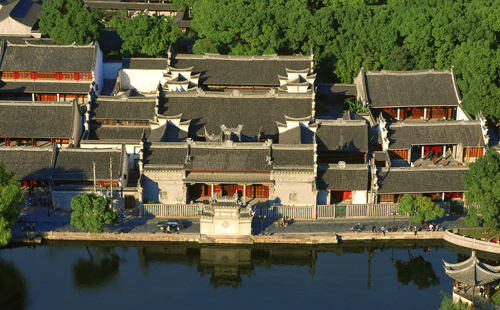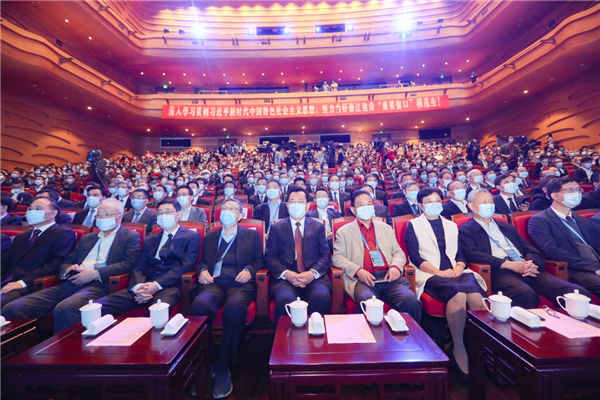Study in Zhejiang
Since ancient times, Zhejiang people have handed down farming and education as their family tradition, emphasizing education as a means to prosper. Since the reform and opening up to the outside world, Zhejiang provincial government has been giving priority to education as a development strategy. In 1992, Zhejiang province set up the strategy of "Rejuvenating Zhejiang via Science and Education" and in 1999, it started to launch a campaign of building prominent counties of education. In 2002, it raised a strategic goal of establishing and developing Zhejiang as a "Prominent Province of Education". In 2006, an outline for establishing a prominent province of education was drawn up. In 2010, the Provincial Outline for Medium and Long-term Education Reform and Development (2010-2020) was formally released. After many years of efforts, Zhejiang has established a complete education system including basic education, vocational education, higher education and continuous education, with basic education in the province remaining its leading place in the whole nation, vocational education making great strides to be listed top and higher education enjoying most rapid development in China.
Leading Position of Basic Education
In 1989, Zhejiang Province universalized its elementary education. In 1997, it became the third province in China to "basically universalize the 9-year compulsory education, and basically eradicate youth's illiteracy". In 2004, Zhejiang Province took a lead in universalizing 15-year education from three-year preschool education all through to senior high school education in China. At present, the rate of universalizing 15-year education has reached 97.6%. In 2011, Zhejiang has 1,870,000 kids in kindergartens, and 6,660,000 students in elementary and secondary schools. Gross enrollment rates in primary and junior secondary school has reached 99.99% and 99.92% respectively. Enrollment rate of 3-year preschool and admission rate of junior secondary school students into senior high school has reached 95.4% and 98.2% respectively. All main indexes of Zhejiang's basic education are taking a leading position in China.
Great Stride in Vocational Education
Secondary vocational education and regular high school education develop coordinately with the annual enrollments comparatively equal. 5-year vocational education was carried out to strengthen the hook-up between secondary and higher vocational education. Now, In Zhejiang province, there are 450 secondary vocational schools with 765,000 students and 46 higher vocational institutions (including 11 model institutions of national level) with 301,000 students. The enrollment of higher vocational institutions accounts for 33.2% of the total enrollment of regular higher institutions in the province. The continuous education is of different types including long-distance education and adult education. The lifelong education system is being gradually established.
Rapid Development in Higher Education
Since the year of 1999, Zhejiang has been sparing no efforts to promote the development of higher education. Six higher education zones including Xiasha, Binjiang, Xiaoheshan of Hangzhou, Zijingang Campus of Zhejiang University, Ningbo and Wenzhou were established. Currently, there are 104 regular higher education institutions (2 institutions being established included) involving 33 undergraduate higher education institutions, 22 independent colleges, 3 specialized higher education institutions and 46 higher vocational institutions. The population of full-time students is 960,000 (including graduates), and the gross enrollment rate has reached 47%. There are 8 doctoral degree awarding institutions and 19 master's degree awarding institutions with 77 first level discipline-based doctoral programs and 249 first level discipline-based master's programs. Those institutions have established an array of key subjects, key laboratories, key programs and talents cultivation bases at the national, provincial and ministerial level. Presently, there are 4 scientific technology parks, 14 key laboratories and 7 research centers at the national level in the province.
Continuous Reinforcement of Guarantee Capability
A guarantee system for education fund has been established and improved wherein government constitutes the main body of the educational funds, supplemented by funds raised from a variety of other sources. In 2011, the education investment reached over 120 billion RMB. The buildings of schools of all levels in the province covered an area of 120 million square meters. The ratio of teachers with required degrees and the ratio of teachers with high level degrees have been greatly enhanced through the following measures: licensed-based teacher qualification system, life-long education system and in-job training. At present, the number of teachers in kindergartens, elementary schools, secondary schools, secondary vocational schools and higher education institutions reached 100,000, 174,000, 183,000, 31,000 and 52,000 respectively. By the end of 2011, there are 30 academicians of the Chinese Academy of Social Sciences or Chinese Academy of Engineering, 47 experts and scholars selected by the national "1000-scholars Scheme", 82 specially-appointed professors of "Chang Jiang Scholars Program", 94 experts selected by the "National Talents Project", 48 provincial-level top senior experts, and 82 specially-appointed professors of "Qian Jiang Scholars" in Zhejiang province.
Vibrant International Exchange and Cooperation
With continuous development in terms of economy and society, international education exchange and cooperation in Zhejiang province becomes increasingly dynamic with stronger awareness of educational internationalization. "Sister Schools Action Plan" for elementary and secondary schools goes in full swing. The University of Nottingham, Ningbo China becomes the first independently established Chinese-Foreign collaborative university in China. At present, 39 universities and over 100 elementary and secondary schools are eligible to enroll overseas students. By the end of 2011, 13,004 overseas students from 161 countries and regions are studying in Zhejiang's higher education institutions, while the number of overseas students studying in elementary and secondary schools has reached over 2,000. Meanwhile, over 3,000 foreign experts and teachers are working in higher education institutions, elementary and secondary schools. Over 12,000 students are sent abroad through student exchange programs each year. The number of self-financed students going abroad amounts to over 15,000. There are 108 Chinese-Foreign collaborative education institutions and programs enrolling over 10,000 students. Ten higher education institutions in Zhejiang province founded 15 Confucius Institutes collaboratively with counterparts in 12 countries. In addition, the provincial government scholarship program of 5,000,000 RMB per year was set up to attract overseas students to study in Zhejiang province in 2009. In 2011, Zhejiang province formally released the Development Planning for Zhejiang Higher Education Internationalization (2010-2020) and Action Plan for Overseas Students Studying in Zhejiang.
Zhejiang Education Marches towards Modernization
In the coming 5 to 10 years, the general strategy of Zhejiang education is to accelerate education modernization comprehensively, and make great efforts to establish "Prominent Province of Education".
The education vision in Zhejiang is as follows: by 2015, to basically realize education modernization with education development level ranking top in the whole nation, and by 2020, to realize education modernization completely, to establish "Prominent Province of Education" with main education indexes reaching the average level of the developed countries.
China Academy of Art,it is one of the biggest fine art institutions in the world.In 1928, the National Academy of Art was founded as the first art academy in China on the bank of the West Lake in Hangzhou by the educator Cai Yuanpei with Lin Fengmian. The China Academy of Art has a range of degree offerings and programs of study in fine arts in China. There are eight schools under its jurisdiction offering Ph.D., Master's and Bachelor's degrees in fine arts, design, architecture, multi-media and film.
About Hangzhou Dianzi University
Located in the historical and cultural city of Hangzhou, China, Hangzhou Dianzi University (HDU) is a key teaching and research oriented university in Zhejiang Province with its own distinctive programs in electronic science and technology as well as business management. The precursor of HDU was the Hangzhou Aviation Industrial Finance and Economics School, which was founded in 1956. In 1980, Hangzhou Institute of Electronics and Engineering was established and the name was changed to Hangzhou Dianzi University in 2004.
There are four campuses of HDU, Xiasha, Wenyi, Dongyue and Xiasha East. In 2000, the main campus of HDU was moved from the downtown Wenyi campus to the new Xiasha campus, and is approximately 329 acres. The university has over 26,000 students in 14 schools. Programs and courses are offered in Mechanical Engineering, Automation, Electronics Information & Engineering, along with multiple and interactive disciplines and specialties.
The university emphasizes comprehensive development of the students and works hard to cultivate high-quality talents with innovative spirits and practical skills. The university is famous for its strict management, lively academic environment and high quality of the students. The students who have graduated from HDU are acclaimed by all their employers and excel in their achievements in important scientific and technological competitions at home and abroad.
The university's dynamic scientific and technological research is well documented in the scientific community. HDU has completed a series of high-tech research projects as well as many state and provincial research funded projects in different fields. Many top achievement awards have been received at the state level for HDU's excellence in scientific performance. Having established stable, cooperative relationships with several hundreds of enterprises in China, the comprehensive index of scientific and technological research of this university has been one of the highest in similar colleges and universities in China and Zhejiang Province. HDU has become an important base in Zhejiang Province to cultivate special talents and transfer scientific and technological research achievements into industrial production.
The university globalization policy shows in our university operation and HDU has established friendly cooperative relationships with many famous universities, transnational enterprises and research institutions in over ten countries.The progressive and cutting edge research and curriculum at HDU makes it one of the finest
universities to select from when deciding on the best education destination. Look into our history, check out our new and modern facilities and we think the choice will be clear that you will be well-served by an education at HDU. We welcome you to study in HDU!
About Zhejiang University of Finance and Economics
Zhejiang University of Finance and Economics (ZUFE) is situated in the prosperous and picturesque city of Hangzhou, which is well known for its history, culture and scenery. It is a provincial university with special distinction in economics and management, which develops harmoniously with diverse disciplines like literature, law, science, engineering, and art. Its predecessor —— the Finance and Banking School of Zhejiang Province, was founded in 1974. In 1987, this school was enlarged and renamed as Zhejiang College of Finance & Economics under the approval of the State Educational Commission of China. It was authorized to confer Bachelor's degrees in 1991 and Master's degrees in 2003. In 2006, the University achieved excellence in the Undergraduate Educational Evaluation conducted by the State Ministry of Education. It has been ranking as one of the most welcomed provincial universities in our province.
As a creative and dynamic higher educational institution, ZUFE always attaches great importance to international exchanges and cooperation with foreign universities. Up to now we have established close and collaborative relations with 69 universities and research institutions in nearly 20 countries and regions, including the U.S.A, the UK, France, Denmark, Japan, Korea and Australia.
Besides, the university offers scholarships to excellent students. Both ZUFE and Zhejiang provincial government offer various scholarships to outstanding international students, so there are many kinds of scholarships available to international students.





 play
play